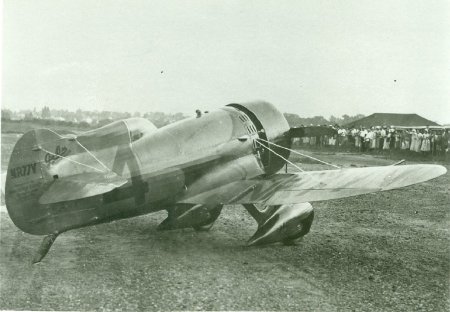Charles E. Thompson, president of Thompson Products, Inc. was approached prior to the 1929 National Air Races in Cleveland, Ohio, to donate a trophy on behalf of the corporation as an award for the featured free-for-all racing event. This historically significant event, and the large silver loving cup donated by Thompson, were won by Doug Davis in the pace-setting Travelair Mystery racer.
Seeing an air classic in the making, Mr. Thompson obtained the sanction of the National Aeronautic Association to hold an unlimited free-for-all event at the annual National Air Races. Four notable sculptors were engaged to submit trophy designs. The clay sketch prepared by Walter A. Sinz of Cleveland was selected and the familiar bronze trophy came into being.
For the ten year period from 1930 through 1939 and during the relatively brief resurgence of the National Air Races following the second World War, the Thompson event was the undisputed, premier, closed-course air race.
Zantford, Thomas, Robert, Mark and Edward Granville of Massachusetts created notable entries into the race. The Gee Bee Super Sportster was a special purpose racing aircraft made by Granville Brothers Aircraft of Springfield, Massachusetts at the now-abandoned Springfield Airport in Massachusetts. Gee Bee stands for Granville Brothers.
The Granville Gee Bee Model Z was an American racing aircraft of the 1930s, the first of the Super Sportster aircraft built by Granville Brothers Aircraft of Springfield, Massachusetts with the sole intent of winning the Thompson Trophy, which it did in 1931 flown by Lowell Bayles.. Model Z was followed in 1932 by the Model R1 and R2 Super Sportsters. The Super Sportster Model R1 won the Thompson Air Races in 1932 flown by Jimmy Doolittle.
1931 GEE BEE SUPERSPORTSTER MODEL Z, black and lemon yellow colors, powered by a Pratt & Whitney Wasp Jr. engine. Lowell R. Bayles purchased stock in the Springfield Air Racing Association and made arrangements to fly this stubby Gee Bee against a field dominated by Jimmy Doolittle in his Laird Super Solution. Doolittle's engine went sour and Bayles had the race to himself, finishing with an average speed of 236.23 mph. 100 mile race-prize purse, $15,000.
1932 GEE BEE SUPERSPORTSTER MODEL R-1, red and white colors, powered by a Pratt & Whitney Wasp engine. Jimmy Doolittle substituted for famed distance flyer Russell Boardman who was injured when he crashed a Gee Bee Sportster a few days before the National Air Races. Doolittle completely dominated the Thompson Trophy Race, finishing with an average speed of 252.68 mph. 100 mile race-prize purse, $10,000.

